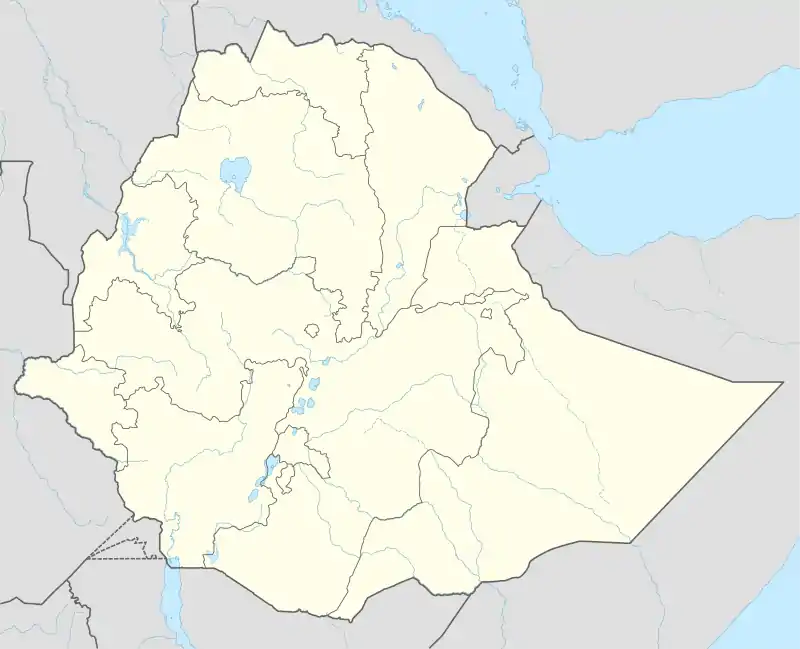Kelafo
Kelafo (Somali: Qalaafe, Amharic: ቀላፎ, romanized: Qällafo) is a town in eastern Ethiopia. Located in the Gode Zone of the Somali Region, this town has a latitude and longitude of 05°35′20″N 44°12′20″E and an elevation of 233 meters above sea level.
Kelafo
Au Calif | |
|---|---|
 Kelafo Location within Ethiopia | |
| Coordinates: 5°35′20″N 44°12′20″E | |
| Country | Ethiopia |
| Region | Somali |
| Zone | Gode |
| Elevation | 233 m (764 ft) |
| Population (2005) | |
| • Total | 14,242 |
| Time zone | UTC+3 (EAT) |
The UN-OCHA-Ethiopia website provides details of the health clinic in Kelafo, which was built in 1991 with funds and equipment provided by the Australian government.[1] Kelafo is served by an airport (ICAO code HAKL), and a bridge across the Shebelle River which was scoured in the May 1995 floods.[2]
History
The city is one of the oldest in the horn of Africa and became the center of the Ajuran Sultanate in the early 13 century. for hundreds of years it served the powerful Ajuran empire that covered a huge part of Somalia and was connecting the trade routes of the Ogaden and that of Southern Somalia.
For a long time the city was ruled by The Gareen dynasty. The House of Garen was the ruling hereditary dynasty of the Ajuran Sultanate. Its origin lies in the Garen Kingdom that during the 13th century ruled parts of the Ogaden, the Somali region of Ethiopia. With the migration of Somalis from the northern half of the Horn region to the southern half, new cultural and religious orders were introduced that influenced the administrative structure of the dynasty, a system of governance which began to evolve into an Islamic government. Through their genealogical Baraka, which came from the saint Balad (who was known to have come from outside the Garen Kingdom), the Garen rulers claimed supremacy and religious legitimacy over other groups in the Horn of Africa. Balad's ancestors are said to have come from the historical northern region of Barbara.
The Gareen empire had collapsed during the late 17th century after ruling for 500 years, and a slow decline had set in over the centuries, leading to the eventual demise of the Ajuran state during the 18th century and the end of strong central leadership amongst the Ajuran. Ajuran tribes lived and still live throughout Somali inhabited lands in Ethiopia, Somalia and Kenya.
According to some Ajuran traditions, Olol Dinle who was related directly to the Gareen Dynasty carved a new Ajuran Sultanate out of the upper reaches of the Wadi Shabelle, centered at Kelafo, the traditional capital at the turn of the 20th century.
Olol Dinle and his sultanate became embroiled in the politics of the day, aligning himself with the Italian colonial authorities. In 1915, Sultan Olol Dinle of Kelafo, Sultan Ali Yusuf Kenadid of Hobyo, and the Italian Somaliland government attempted to dislodge the Darwiish forces of Sayyid Mohammed Abdullah Hassan, who had conquered territory near Beledweyne in their rapid advance southwards. In recognition of Italy's alliance with Olol Dinle, he was dubbed the "Sultan of Sciavelli (Shabelle)" in the early 1930s.
Early in the Ogaden War, Kelafo was captured by the Somali Army. It was recaptured by opposing units in March 1978.
Demographics
Based on figures from the Central Statistical Agency in 2005, this town has an estimated total population of 14,242, of whom 7,522 are men and 6,720 are women.[3] The 1997 census reported this town had a total population of 9,551 of whom 4,970 were men and 4,581 women. The largest two ethnic groups reported in this town were the Somali (96.85%), and the Amhara (1%); all other ethnic groups made up 2.15% of the population.[4] It is the largest town in Kelafo woreda.
Notes
- Frederic Vigneau, "Field Report of Gode and Kalafo zones" Archived 2010-10-08 at the Wayback Machine, UN-OCHA website, August 1994 (accessed 26 February 2009)
- "Update on Response to Floods of Gode Zone", UN-EUE June 1995 (accessed 26 February 2009) Archived October 8, 2010, at the Wayback Machine
- CSA 2005 National Statistics, Table B.4 Archived November 23, 2006, at the Wayback Machine
- 1994 Population and Housing Census of Ethiopia: Results for Somali Region, Vol. 1 Archived November 19, 2008, at the Wayback Machine Tables 2.4, 2.14 (accessed 10 January 2009). The results of the 1994 census in the Somali Region were not satisfactory, so the census was repeated in 1997.
